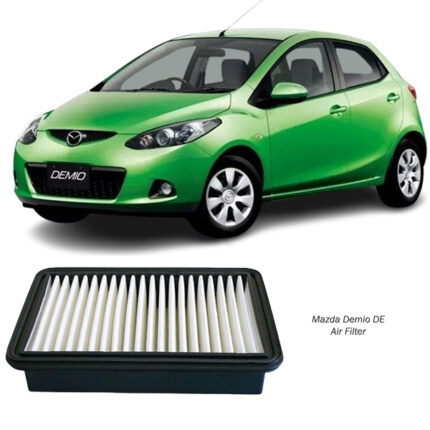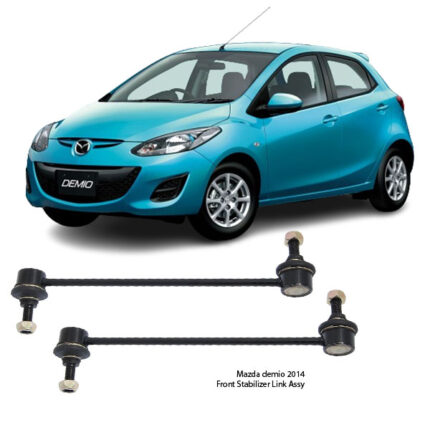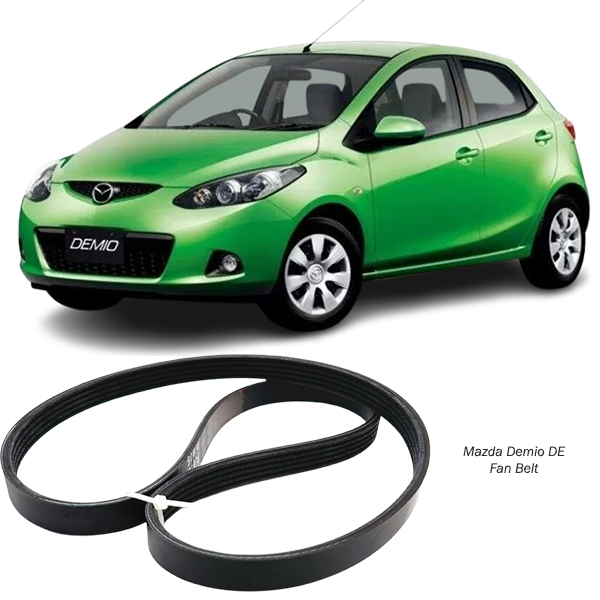-10%
Get Mazda Demio DE Alternator Fan Belt 6PK1840 in Kenya
The alternator fan belt, also known as the serpentine belt or drive belt, is a critical component of a vehicle’s engine system. It transfers mechanical power from the engine’s crankshaft to the alternator, which generates electricity to charge the battery and power various electrical systems. Additionally, this belt often drives other vital accessories, such as the power steering pump, water pump, and air conditioning compressor.
This guide explores the alternator fan belt in detail, covering its structure, functions, types, benefits, maintenance, signs of wear, and replacement procedures.
Structure of the Alternator Fan Belt
The alternator fan belt is a durable, continuous loop of reinforced rubber. Its design ensures efficient power transfer and resistance to wear. Key structural features include:
- Outer Layer
Made of high-quality synthetic rubber, this layer resists heat, oil, and abrasion. - Reinforcement Layer
Reinforced with materials like polyester or aramid fibers, this layer provides strength and reduces stretch. - Grooved Surface
The belt’s grooves enhance grip and allow it to fit snugly onto pulleys, minimizing slippage.
Functions of the Alternator Fan Belt
- Power Transmission
The primary role of the alternator fan belt is to transfer power from the crankshaft to the alternator and other engine accessories. - Energy Efficiency
By efficiently linking multiple components, the belt reduces energy waste and optimizes engine performance. - Accessory Drive
In modern vehicles, a single serpentine belt often powers multiple components, including:- Alternator: Charges the battery and powers electrical systems.
- Water Pump: Circulates coolant to regulate engine temperature.
- Power Steering Pump: Provides hydraulic assistance for steering.
- Air Conditioning Compressor: Powers the A/C system for cabin cooling.
Types of Alternator Fan Belts
- V-Belts
- Older design with a trapezoidal cross-section.
- Typically used in vehicles with separate belts for each accessory.
- Serpentine Belts
- Modern design with multiple grooves on one side.
- Powers multiple accessories using a single belt.
- Compact, efficient, and easy to maintain.
- Ribbed Belts
- Similar to serpentine belts but with finer grooves for better flexibility.
- Common in high-performance vehicles.
- Cogged Belts
- Have notches or cogs for improved flexibility and reduced slippage.
Benefits of a Well-Maintained Alternator Fan Belt
- Efficient Power Delivery
A properly functioning belt ensures seamless operation of engine accessories. - Enhanced Vehicle Reliability
Regular maintenance minimizes the risk of belt failure, preventing breakdowns. - Optimal Engine Performance
Ensures the alternator charges the battery effectively and maintains proper electrical system function. - Reduced Maintenance Costs
Preventive care reduces the likelihood of damage to related components. - Improved Fuel Efficiency
A well-maintained belt reduces unnecessary strain on the engine, optimizing fuel consumption.
Signs of a Worn or Damaged Alternator Fan Belt
- Squealing or Chirping Noises
High-pitched noises when starting the engine or during acceleration indicate slippage or misalignment. - Cracks or Fraying
Visible cracks, fraying edges, or missing grooves signal that the belt is nearing the end of its life. - Loss of Power to Accessories
Flickering headlights, weak A/C performance, or difficulty steering can indicate belt issues. - Overheating Engine
If the belt fails to drive the water pump, the engine may overheat. - Slack or Loose Belt
A loose belt reduces tension, causing inefficiency and potential damage to components.
Causes of Alternator Fan Belt Wear
- Aging and Wear
Over time, the rubber material degrades due to heat, friction, and exposure to contaminants. - Improper Tension
Excessive or insufficient tension accelerates wear and reduces belt lifespan. - Misalignment
Misaligned pulleys create uneven stress on the belt, leading to premature failure. - Contaminants
Oil, coolant, or road debris can weaken the belt’s material. - Overloading
High accessory loads increase strain on the belt, particularly in high-demand conditions.
Maintenance of the Alternator Fan Belt
- Regular Inspections
- Check the belt for cracks, fraying, or uneven wear during routine vehicle maintenance.
- Inspect tensioners and pulleys for proper alignment and function.
- Tension Adjustment
- Ensure the belt has the correct tension. A loose or overly tight belt reduces efficiency and causes damage.
- Cleaning
- Wipe off oil, grease, or debris to prevent material degradation.
- Timely Replacement
- Replace the belt as recommended by the manufacturer, usually every 60,000 to 100,000 kilometers.
Steps to Replace an Alternator Fan Belt
Tools Needed
- Socket wrench set.
- Belt tensioner tool or pry bar.
- Replacement belt (ensure it matches the original specifications).
Procedure
- Locate the Belt
- Open the hood and locate the alternator fan belt and associated pulleys.
- Inspect the Belt Routing Diagram
- Refer to the vehicle’s manual or under-hood diagram for correct belt routing.
- Release Tension
- Use a tensioner tool to relieve tension on the belt.
- Remove the Old Belt
- Slide the belt off the pulleys carefully.
- Inspect Components
- Check the tensioner, idler pulleys, and accessories for wear or damage.
- Install the New Belt
- Follow the routing diagram to position the new belt over the pulleys.
- Reapply Tension
- Adjust the tensioner to apply the proper tension to the belt.
- Double-Check Alignment
- Ensure the belt is seated correctly in all grooves and aligned with the pulleys.
- Test the Vehicle
- Start the engine and observe the belt operation for smoothness and proper tension.
Common Mistakes to Avoid
- Using the Wrong Belt
An incorrectly sized belt may slip or cause premature wear. - Skipping Component Inspection
Neglecting to check pulleys and tensioners can lead to rapid belt failure. - Overtightening the Belt
Excessive tension can strain accessories and reduce belt lifespan. - Ignoring the Routing Diagram
Incorrect routing can lead to accessory malfunction and belt damage.
Why Invest in a High-Quality Alternator Fan Belt?
- Durability
Premium belts withstand heat, tension, and wear, offering longer service life. - Efficiency
A high-quality belt ensures smooth and reliable operation of engine accessories. - Cost-Effectiveness
While initially more expensive, superior belts reduce the frequency of replacements and repairs.
Conclusion
The alternator fan belt is indispensable for the proper functioning of a vehicle’s electrical and accessory systems. Regular inspection, timely replacement, and the use of high-quality components are crucial for maintaining optimal performance and preventing unexpected breakdowns. By understanding the alternator fan belt’s role and adhering to best practices for maintenance, drivers can ensure a smoother, safer, and more efficient driving experience.



